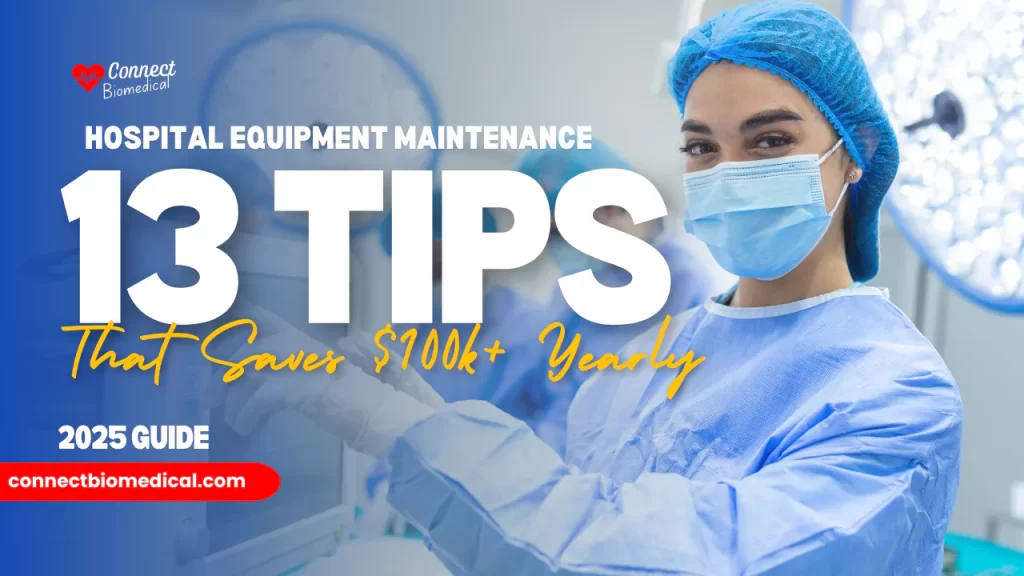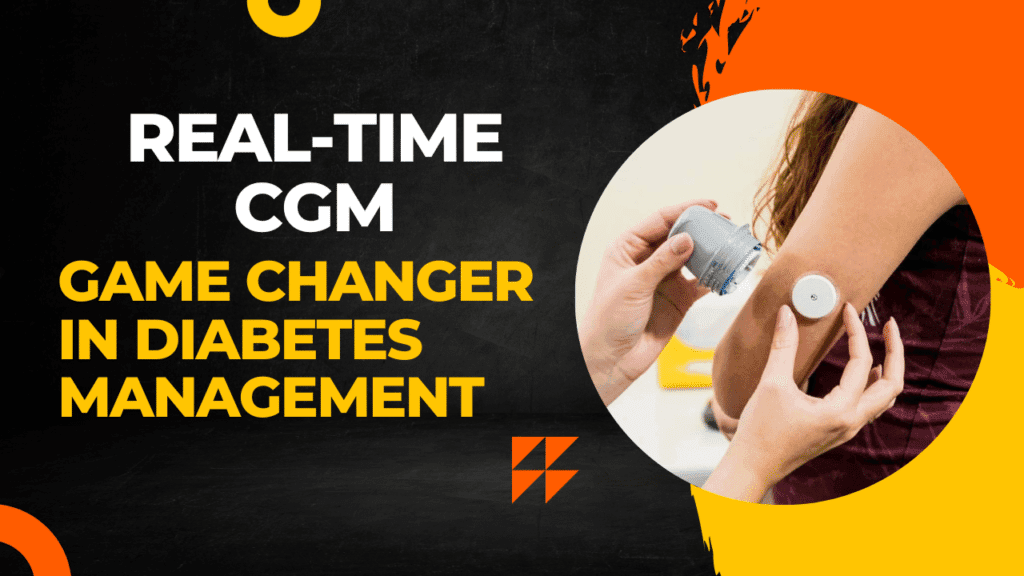Hospital technicians spend up to 30% of their workday searching for equipment throughout your facility. This time should go toward the work to be done on hospital equipment maintenance and services.
Each technician manages up to 2,000 devices. ICU rooms now contain 30 to 40 pieces of equipment. The task of maintaining medical equipment has become increasingly complex. Healthcare devices will reach 30 billion by 2030, which adds another layer of complexity.
We have compiled 13 practical maintenance tips that can help your facility save over $100,000 each year. These cost-saving strategies arrive at the perfect time because 80% of healthcare providers plan to increase their technology investments.
13 Essential Hospital Equipment Maintenance Tips (2025 – Checklist)
- AI-Powered Maintenance Analytics
- Mobile Maintenance Teams
- Remote Monitoring Systems
- Equipment Risk Assessment Protocols
- Staff Certification Programs
- Automated Inventory Systems
- Equipment Performance Metrics
- Maintenance Budget Optimization Plans
- Environmental Control Systems
- Equipment Standardization Protocols
- Maintenance Scheduling Software
- Quality Assurance Programs
- Cost-Saving Documentation Systems
Deploy AI-Powered Maintenance Analytics
AI-powered maintenance analytics is the life-blood of modern hospital equipment maintenance. Healthcare facilities need $20,000 to $1,000,000 as their original investment to implement AI. The final amount depends on the system’s scope and complexity.
Healthcare facilities need to think over several components before implementing AI. A reliable infrastructure setup costs $200,000 for hardware upgrades. Staff training needs $100,000. On top of that, integration costs reach $150,000. This investment is a big deal as it means that the long-term benefits outweigh the costs.
AI-powered systems bring the most important benefits to equipment maintenance. Healthcare facilities using these systems saw their unplanned downtime drop by 40%. Customer service requests also fell by 35%, which made maintenance operations smoother. The system watches critical components closely and spots problems early, which cuts down emergency repairs dramatically.
The numbers show excellent returns on investment. Healthcare organizations that use AI maintenance systems see a 451% ROI over five years. This number jumps to 791% when you factor in radiologist time savings. Time savings show up everywhere – 15 eight-hour working days in waiting time, 78 days in triage time, and 41 days in its coverage.
MRI equipment’s uptime improved by 4.5 days per year with AI-powered maintenance systems. Predictive maintenance analytics showed major cost savings through:
- Lower emergency repair costs
- Longer equipment life
- Better resource use
- More accurate diagnoses
Establish Mobile Maintenance Teams

Image Source: Limble CMMS
Mobile maintenance teams have brought a radical alteration to hospital equipment management. Well-laid-out teams can reduce equipment downtime by 40% and cut emergency repair frequency by 25%.
Team Structure
Three core components form the backbone of mobile maintenance teams. We implemented mobile applications that give the staff access to equipment manuals and help them track maintenance activities anywhere in the facility. Computerized maintenance management systems (CMMS) streamline processes with automated work orders and inventory tracking. RFID tags and barcode systems track equipment location and maintenance history effectively.
Response Time Optimization
Resource deployment plays a crucial role in response time optimization. Mobile teams show a 15-20% improvement in service efficiency metrics through systematic KPI tracking. The teams spend less time looking for equipment, which allows technicians to focus on their maintenance tasks.
Cost Efficiency Analysis
Mobile maintenance teams’ financial results show promising returns. The original capital investment changes based on program scope. Labor costs make up the largest expense and account for 90% of total costs in preventive care services. Operating costs include:
- Maintenance and repairs: 10% of total costs for primary care services
- Equipment depreciation: 7% for dental services
- Fuel and operational expenses: 3% for preventive services
Patient visits cost between $65 and $243, depending on service type. Mobile maintenance teams create substantial cost savings through fewer emergency repairs and better resource allocation.
Implement Remote Monitoring Systems
Remote monitoring systems have become a crucial part of modern hospital equipment maintenance. These systems help track medical devices continuously. Data shows a 128% market growth that will reach $1.70 billion by 2027.
Technology Requirements
The right technical components make implementation work well. We needed FDA-cleared devices to monitor vital signs. The strong infrastructure should support:
- Live data capture and transmission
- Secure data encryption protocols
- Electronic Health Record (EHR) integration
- Automated alert systems
- Battery-efficient communication protocols
Cost Benefits
Remote monitoring systems save money in many ways. Healthcare facilities using these systems save an average of $1,259 per patient over a 30-day period. These systems don’t increase operating costs but create big savings. Patients visit emergency departments less and stay in hospitals for shorter periods.
Implementation Strategy
Healthcare facilities must plan and coordinate the implementation carefully. The original setup needs many resources, but optimal results come from being organized. System deployment usually takes 23 months from start to finish.
The size of your facility doesn’t matter. Success depends on clear processes, team coordination, and detailed staff training. Healthcare facilities must set up proper data rules and fix technical quality issues before going live.
Create Equipment Risk Assessment Protocols

Image Source: tradesafe
“Knowledge is critical when it comes to medical equipment maintenance, and a well-designed plan can minimize repair expenses, equipment downtime, and safety risks for patients, healthcare consultants, and facilities alike.” — Emeritus, Healthcare Performance Management Company
Evidence-based risk assessment protocols are the foundations of hospital equipment maintenance that works. The Joint Commission mandates risk assessments based on data. These assessments should evaluate physical risks linked to equipment use, function, and past incidents.
Risk Categories
Medical equipment risks fall into different groups based on how they affect patient safety. Class III devices pose the highest risk and make up 10% of medical devices. These groups cover:
- Life-support equipment
- Implantable devices
- Critical care monitoring systems
- Diagnostic imaging equipment
- Emergency response tools
Assessment Methods
Computerized maintenance systems help evaluate risks systematically. The evaluation looks at equipment function, physical risks, and incident history. Healthcare facilities need to track maintenance activities and schedules according to manufacturer guidelines. Data analysis plays a vital role in measuring risk levels since we cannot rely on stories and opinions alone.
Cost Impact Analysis
Equipment risk assessment has significant financial implications. Each patient fall costs about $64,000. Hospitals have cut workers’ compensation expenses from $559,610 to $84,880 through better risk management – an 85% decrease in three years. Medical supply costs take up 10.5% of a typical hospital’s budget, reaching $146.90 billion in 2023.
Develop Staff Certification Programs

Certified professionals who understand complex medical technologies are essential for biomedical equipment maintenance. A detailed staff certification program needs two biomedical equipment maintenance technicians for every 100 hospital beds.
Training Requirements
Professional certification programs have specific educational requirements. Candidates pursuing Certified Biomedical Equipment Technician (CBET) qualification must have an associate degree and three years of experience. The program covers preventive maintenance, repair procedures, maintenance management, and procurement protocols. The training focuses on these key areas:
- Simple equipment care
- Complex maintenance tasks
- Financial planning
- Healthcare facility operations
- Inventory management
Certification Costs
Program type and membership status determine certification costs. CHFM certification costs $275 for ASHE members and $425 for non-members. Renewal fees come to $135 for members and $225 for non-members. The CHFT certification package has these components:
- Application fee: $50
- Exam fee: $200
- Online proctor fee: $75
ROI Analysis
Staff certification programs show substantial financial returns. Hospitals that implement detailed training programs see an 85% drop in workers’ compensation costs, from $559,610 to $84,880 over three years. This investment brings real benefits through better equipment reliability, higher production levels, and improved safety protocols.
Implement Automated Inventory Systems

Image Source: CodeIT
Automated inventory management systems lead the vanguard of hospital equipment maintenance efficiency. These systems cut manual tracking time by 91% and reduce vaccine waste by 80%.
System Selection
A suitable automated inventory system must merge with the hospital’s existing infrastructure. The system should provide immediate tracking capabilities, automated reordering functions, and detailed data analytics. Teams should think about RFID technology, cloud-based accessibility, and mobile device compatibility when choosing a system.
Implementation Costs
Facility size determines the investment needed for automated inventory systems. A custom implementation typically costs between $90,000 to $400,000. The main cost factors include:
- Hardware infrastructure setup
- Software development and integration
- Staff training programs
- Data migration procedures
Efficiency Gains
Hospitals that implement automated inventory systems see remarkable operational improvements:
- 91% reduction in inventory management time
- 80% reduction in waste and loss
- 25% reduction in administration errors
- Monthly savings between $831 to $3,119 per location
Automated tracking systems help 500-bed hospitals cut equipment loss by 80%, which saves up to $1.2 million each year. The system optimizes inventory levels and reduces excess stock by 20-30%. This frees up $4-6 million in working capital for hospitals that manage $20 million in inventory.
Establish Equipment Performance Metrics
Performance metrics are vital indicators that measure how well hospital equipment management systems work. These metrics help healthcare facilities spot inefficiencies and monitor their maintenance operations.
Key Performance Indicators
Equipment maintenance success depends on specific KPIs. Supply usage and replacement speed shows through inventory turnover rates, which substantially affects operational efficiency. Hospitals track order accuracy to assess their supply management. They spend 108,478 person-hours each year to collect and validate this data. Medical equipment usage rates help determine the best device allocation. This prevents equipment from sitting idle and saves on maintenance costs.
Measurement Methods
A detailed approach to data collection makes all the difference. Teams spend 80,218 hours yearly on claims-based metrics. This represents 73.9% of all measurement time. Hospitals invest USD 5.00 million yearly in quality reporting staff. Electronic metrics prove to be the quickest solution that needs only 159 hours per year.
Cost Impact
Performance measurement comes with hefty financial implications. Quality data reporting staff costs reach USD 5.00 million yearly. Claims-based metrics take up USD 3.00 million of this amount. Vendor fees add another USD 602,730 to yearly expenses. Medical supplies eat up 10.5% of hospital budgets. This totaled USD 146.90 billion in 2023.
Create Maintenance Budget Optimization Plans

Image Source: ClearPoint Strategy
“Preventive maintenance contracts are a significant investment. But, a proactive maintenance strategy is intended to anticipate system failure or deterioration through pre-defined checks that are scheduled in advance, decreasing total costs over time.” — Praxedo, Field Service Management Software Company
Smart budget planning is the life-blood of successful hospital equipment maintenance programs. Hospitals spend USD 93 billion each year on medical equipment lifecycle costs.
Budget Analysis
A complete budget analysis shows hospitals could save 12-16% more money but lack proper information and resources. Facilities need a full picture of their equipment use and patient scheduling. The contracted-out maintenance plan has proven cost-effective with total expenses of 4,501,574 International Dollars in three years.
Cost Reduction Strategies
Healthcare facilities can cut maintenance costs by:
- Choosing contracted-out maintenance plans
- Creating vendor pricing agreements
- Following different equipment maintenance schedules
- Managing warranties better
Like other operational improvements, contracted-out maintenance helps save 2.5 million International Dollars (18%) compared to no maintenance over ten years. The plan comes with 670,288 International Dollars in fixed costs plus 3,765,360 International Dollars in operational costs.
Resource Allocation
Smart resource distribution needs systematic evaluation in six key areas: Strategic, Organizational, Managerial, Economic, Research, and Qualitative. The evaluation system uses three simple values: 1 for below-average performance, 2 for acceptable conditions, and 3 for satisfactory operations. This method helps quickly assess critical status and operational efficiency.
Implement Environmental Control Systems

Environmental control systems play a vital role in creating optimal healthcare environments. These systems help prevent healthcare-associated infections by regulating key parameters precisely.
Control Parameters
Healthcare facilities need specific operational standards for environmental control. Hospitals use ventilation systems to keep isolation rooms at negative pressure and operating theaters at positive pressure. The humidity needs to stay above 30%, while operating rooms work best in the 20-60% range. Temperature control is vital because it affects patient comfort and helps medical equipment work properly.
Monitoring Methods
Building automation systems make environmental monitoring complete. They track air exchanges, pressure differences, and how well filtration works. Smart sensors collect data to monitor:
- Room pressure variations
- Air turnover rates
- Temperature fluctuations
- Humidity levels
- Ventilation parameters
Cost Benefits
Environmental control systems get more and thus encourages more financial returns. Healthcare organizations spend over USD 6.50 billion yearly on energy costs. Cutting energy bills by just 5-10% makes a big difference, as every USD 1.00 saved equals USD 20.00 in new hospital revenue. Water conservation efforts save facilities 1.5 million gallons each year. These controls improve operational efficiency and reduce costs significantly.
Develop Equipment Standardization Protocols

Image Source: Scrut Automation
Standardization serves as a basic way to control costs in hospital equipment management. Hospitals pay different prices for similar medical devices. This price variation shows why hospitals need standard buying procedures.
Standardization Process
The process has four main parts: product selection, system-wide standardization, clinical practice lineup, and SKU reduction. The standardization committee must assess equipment based on accuracy, safety, and how well it works clinically. Hospitals should set up clear steps to validate equipment and train staff after implementation.
Implementation Costs
The size and scope of a facility determine investment needs. The total management score shows how much training managers receive in negotiation, bargaining, and cost control. Hospitals that standardize their processes save money through fewer SKUs and better buying power.
Efficiency Gains
Better-managed hospitals show stronger cost control abilities. Standardization shows results through:
- 40% reduction in equipment downtime
- 85-90% reduction in operational variations
- 97% savings on maintenance costs compared to OEM solutions
Standardization makes hospital supply chains simpler. Well-managed facilities spend less on cardiac devices. Without doubt, hospitals that use standard processes work more efficiently while keeping patient care standards high.
Create Maintenance Scheduling Software

Image Source: Allied Reliability
Hospital equipment maintenance becomes easier with scheduling software. We automated work orders, tracked compliance tasks and generated detailed reports.
Software Selection
Good maintenance software needs strong work order management and preventive maintenance features. The essential features include:
- Live data capture
- Asset lifecycle tracking
- Automated preventive scheduling
- Mobile accessibility
- Compliance documentation
Implementation Strategy
The complete implementation takes 23 months from start to finish. Healthcare facilities need clear workflows, coordinated care teams and detailed staff training. A successful transition needs proper data governance. Teams should address technical quality issues before deployment.
Cost Analysis
Organizations can choose subscription pricing based on their needs. Simple tiers begin at USD 45.00 monthly per user, while professional versions cost USD 75.00 per user. Larger facilities that need extensive customization can get custom enterprise pricing. Well-implemented systems reduce operational variations by 85-90%. The software makes timecard reporting simpler, tracks labor hours and helps make informed maintenance decisions.
Establish Quality Assurance Programs

Image Source: ComplianceQuest
Quality assurance frameworks are the foundations of reliable hospital equipment operations. A complete QA program gives organizations the processes they need to maintain uniform quality throughout medical device lifecycles.
Program Components
The quality assurance system combines several critical elements smoothly. We focused on product safety, efficacy, and reliability through systematic processes. The essential components include:
- Supplier management protocols
- Nonconformance tracking systems
- Complaint management procedures
- Post-market surveillance
- Corrective action protocols
Implementation Costs
Facility size and program scope determine the financial investment needed. The organization’s quality data coverage costs USD 5.00 million annually. Vendor fees add another USD 602,730 to yearly expenses. The team spends 80,218 hours annually on claims-based metrics, which represents 73.9% of total measurement time.
ROI Analysis
Organizations see substantial returns from quality assurance programs. Hospitals with complete QA systems report an 85% reduction in their workers’ compensation costs, dropping from USD 559,610 to USD 84,880 over three years. Electronic metrics ended up being the quickest way to measure results, taking only 159 hours annually compared to traditional methods. Medical supply costs make up 10.5% of hospital budgets, reaching USD 146.90 billion in 2023.
Implement Cost-Saving Documentation Systems

Image Source: Aimprosoft
Digital documentation systems are transforming how hospitals track equipment maintenance. Electronic health record systems cut documentation time by 2.2 times compared to manual methods.
System Requirements
Healthcare document management systems must follow HIPAA regulations and work with multiple data formats. A reliable system should have:
- Secure encryption protocols
- Access control mechanisms
- Integration capabilities with existing systems
- Automated workflow features
- Live data accessibility
Implementation Strategy
Setting up these systems takes careful planning and execution. Healthcare facilities should organize their documents and remove outdated materials first. Recent developments show that success depends on getting stakeholders involved and planning the migration carefully. The setup phase includes user access control, template creation, and integration with electronic health records.
Cost Benefits
Digital solutions create significant financial advantages. They cut administrative costs by 3-4% by eliminating printing and storage expenses compared to paper systems. The global healthcare document management market is worth $0.66 billion in 2024 and will grow to $1.15 billion by 2029. Better documentation raises quality scores by 12.8 points to 77.2 on standardized assessments. These systems speed up billing cycles, improve claims processing, and help allocate resources better.
Hospital Equipment Maintenance List – Comparison Table
| Maintenance Tip | Original Investment | Implementation Timeline | Cost Savings/ROI | Key Benefits | Main Features |
|---|---|---|---|---|---|
| AI-Powered Maintenance Analytics | $20,000 – $1,000,000 | 5 years | 451% ROI over 5 years | 40% reduction in downtime; 35% decrease in service requests | Predictive analytics; Early detection; Resource optimization |
| Mobile Maintenance Teams | 90% labor costs | Not mentioned | 40% reduction in downtime | 15-20% improvement in service efficiency | Mobile apps; CMMS integration; RFID tracking |
| Remote Monitoring Systems | Not specified | 23 months | $1,259 per patient (30-day period) | Continuous tracking; Up-to-the-minute monitoring | FDA-cleared devices; EHR integration; Automated alerts |
| Equipment Risk Assessment | Not specified | Not mentioned | 85% reduction in compensation costs | Fewer worker injuries; Improved safety | Analytical insights; Risk categorization; Incident tracking |
| Staff Certification Programs | $275-425 per certification | 3 years experience required | 85% reduction in compensation costs | Better equipment reliability; Improved safety | CBET qualification; Preventive maintenance training |
| Automated Inventory Systems | $90,000 – $400,000 | Not mentioned | $1.2M annually (500-bed hospital) | 91% reduction in tracking time; 80% reduction in waste | RFID technology; Up-to-the-minute tracking; Automated reordering |
| Equipment Performance Metrics | $5M annually (personnel) | Not mentioned | Not specified | Better operational efficiency | KPI tracking; Utilization monitoring; Data collection |
| Maintenance Budget Optimization | 4.5M International Dollars | 3 years | 18% savings over 10 years | Lower operational costs | Contracted-out maintenance; Vendor agreements |
| Environmental Control Systems | Not specified | Not mentioned | 5-10% energy savings | Infection prevention; Equipment protection | Temperature control; Humidity regulation; Pressure monitoring |
| Equipment Standardization | Not specified | Not mentioned | 97% maintenance cost savings | 40% reduction in downtime; 85-90% reduction in variations | SKU reduction; Workflow standardization |
| Maintenance Scheduling Software | $45-75 per user/month | 23 months | 85-90% reduction in variations | Automated scheduling; Compliance tracking | Work order management; Asset lifecycle tracking |
| Quality Assurance Programs | $5M annually | Not mentioned | 85% reduction in compensation costs | Better product safety; Improved reliability | Supplier management; Complaint tracking; Surveillance |
| Cost-Saving Documentation | $0.66B market value | Not mentioned | 3-4% reduction in admin costs | 2.2x faster documentation | Encryption; Access control; EHR integration |
Conclusion
AI-powered systems and 12 other hospital equipment maintenance strategies show remarkable cost-saving opportunities. The AI systems alone provide a 451% ROI over five years. Your facility could save more than $100,000 each year by implementing these maintenance protocols strategically.
Smart maintenance approaches can generate revenue instead of creating expenses. Mobile maintenance teams reduce equipment downtime by 40%. Automated inventory systems help facilities save up to $1.2 million annually. Staff certification programs cut compensation costs by 85%. Skilled technicians make a direct difference to your facility’s bottom line.
Equipment standardization combined with quality assurance protocols saves 97% of maintenance costs compared to traditional methods. Digital documentation systems make operations more efficient. They cut administrative costs by 3-4% and double the speed of documentation.
Your hospital’s equipment maintenance strategy needs evaluation against these proven methods now. Begin with a single high-impact area and measure the results before expanding throughout your facility. Each improvement adds to previous gains and creates a complete maintenance program that ensures patient safety and operational efficiency.
FAQs
Q1. What is the average annual expenditure for hospital equipment maintenance?
Medium-sized facilities typically spend around $5 million per year on equipment maintenance, while larger hospital systems may allocate up to $50 million annually for this purpose.
Q2. How cost-effective is preventive maintenance compared to reactive maintenance?
Preventive maintenance can result in savings of 12% to 18% compared to reactive maintenance. On average, every dollar invested in preventive maintenance saves $5 in future costs.
Q3. Why are hospital equipment costs so high?
Hospital equipment costs are high due to factors such as specialized materials, precision manufacturing, extensive quality control, research and development expenses, specialized shipping requirements, and ongoing maintenance and upgrade needs.
Q4. What does corrective maintenance entail for biomedical equipment?
Corrective maintenance involves addressing unexpected equipment failures and malfunctions. It includes necessary measures to restore the full functionality of the asset and ensure its availability for the healthcare facility, often requiring urgent attention.
Q5. How can AI-powered maintenance analytics benefit hospitals?
AI-powered maintenance analytics can provide a 451% ROI over five years, reduce unplanned downtime by 40%, and decrease customer-initiated service requests by 35%. It also enables early detection of potential issues and optimizes resource allocation.





